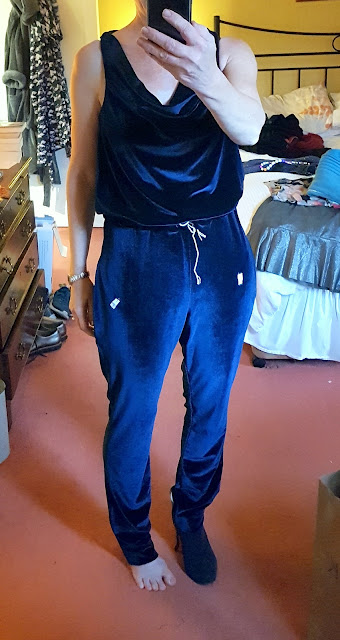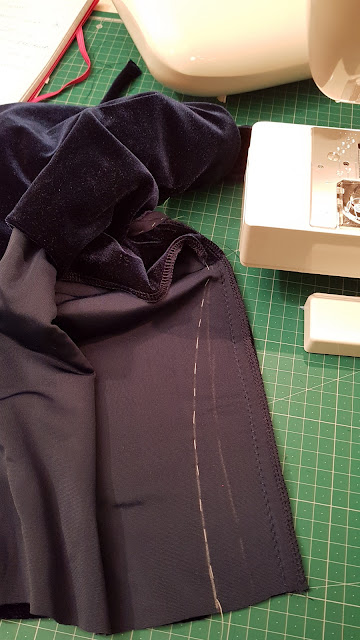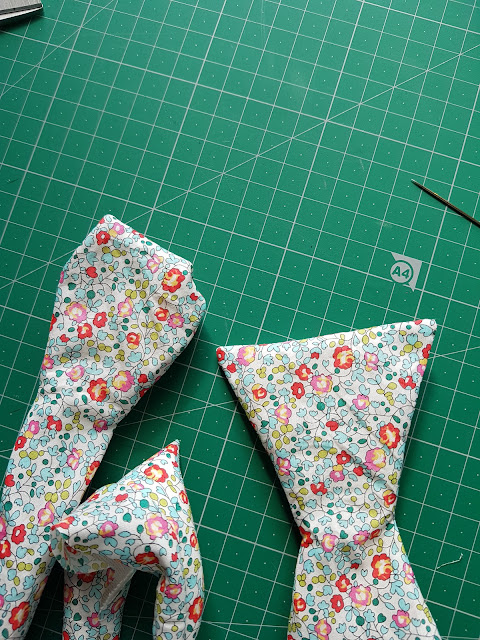At the beginning of the year we found out that one of our much loved cousins had just got engaged. There was much excitement and speculation about plans and clothes! The groom, Joe, got in contact and asked whether I would be prepared to either head up a working party or do it myself, to make him and his groomsmen ties for the wedding. His initial idea was to have bow ties for all, but on discussion with his mates and brothers decided that they would all have normal ties and he would have the bow tie.

We had a fantastic day shopping for fabric - he had a swatch of the fabric for his suit and had expressed a liking for Liberty style fabrics. I knew Joe was colour blind, but hadn't appreciated which colours he
can't 'see' - I spent a lot of time trying to explain what different
colours were and which ones were which, which made for quite an entertaining time. I took him to Fabric Galore as I had heard they have a range of Liberty fabric, but we didn't find anything that he liked. Our plan then was to go to Shaukat in Kensington, and if we didn't find anything there then we would aim for Liberty itself. Shaukat is a shop that sells exclusively Liberty fabric for less than Liberty, and it has masses of stock (much more than Liberty does) both of current fabrics and past.
We got to Shaukat and couldn't believe the range of fabric there. After feeling a little overwhelmed we found the perfect fabric:
After leaving Shaukat, we went to MacCulloch and Wallace, where I had already scouted out the tie canvas for the lining of the ties and we also bought the silk for the tips of the ties.
Having made a tie for my husband a couple of years ago, using an old tie of his as the pattern I was ready to go.
I felt that I had a pretty good idea of what I was doing, but wanted to read a bit about tie making before I started. There are a lot of tutorials on how to make a machine sewn tie, but not much information on sewing a 'proper' tie. The most informative site that I found regard the making of ties was
Thread Theory, the Canadian menswear pattern company. They have a very useful tutorial for
making a silk tie, complete with links to various sources that
they had found useful.
I tidied up the pattern that I had made from the old tie and had taken on board the request from one of Joe's brothers that the ties not be 'kipper' ties! I had shown him the pattern piece and I think he thought that would be the finished size! There was a lengthy discussion on the finished width of the larger end of the tie - 2 3/4 inches/just under 7cm was the final decision.
I had done quite a bit of prep to try and work out how much fabric I would need for 9 ties and 2 bow ties (the second bow tie was for the brides dog!). As you can see above, ties are cut on the bias to allow some stretch when they are being tied. I had hoped that there would be a magic formula on the internet but I couldn't find much that was helpful. I ended up cutting multiple tie pieces from paper, laying them out and measuring the amount of space they took up. Unfortunately I did not make a note of the metreage I thought I would need, nor the amount that we actually bought.
Above are all the pieces for the ties - Each tie is made of three pieces, plus 2 lining pieces for the tips of the ties (the white triangular-ish bits) and the lining so that was 54 cut pieces of fabric for the ties and 6 cut pieces for the bow ties!
I batch sewed all the different tasks - so I sewed all the tie pieces together and pressed the seams, then sewed one side of the tips for all ties before sewing the other side of the tips. It sounds quite complex but the batch sewing really helped me keep organised with everything.
Having constructed all the ties and pressed all the tips, I then added the tie canvas - the strip of canvas is laid down the middle of the tie, then the edges are folded in. These edges can overlap slightly and this is the central seam down the back of a tie. This seam is hand sewn carefully so that the stitches are not too tight. If the stitches are too tight then the tie can pucker and not stretch sufficiently when it is being tied.
Having completed all the ties I was super pleased with how they had turned out, but I wanted a little extra to make them even more special. I thought it would be nice to put some sort of label in and spent quite some considerable time trying to find somewhere that could do a small quantity of printed fabric labels. After extensive search of the internet I found a company called
Bags of Love whose minimum order was 20 (still more than I needed but much better than 50, 75, 100, 250 that all the other places I had found) for about £20. You can chose the size of your label from a selection, add text, colour of text, images etc. I chose to have the bride and grooms names and their wedding date in a colour that went with the tie. They looked perfect and I was almost as pleased with the labels as I was with the ties!
I used a pattern for the bow tie that I had found on the internet - the one I ended up using was from
Sew Like My Mum. This was one of very few patterns for tie-able bow ties, rather than a pre-tied nonadjustable bow tie. Making the bow ties was pretty simple, the trickiest bit was turning the ties right side out and making sure that the corners were nice and crisp. A good press made what started off looking like a crumpled rag look pretty smart!
So after all that, here are some pictures of the ties in action:































